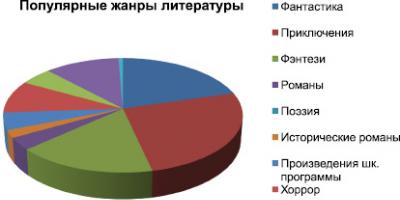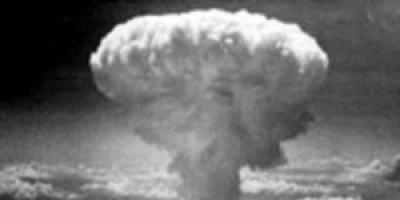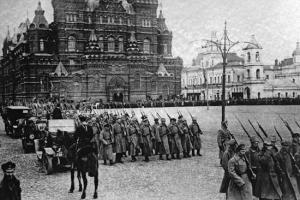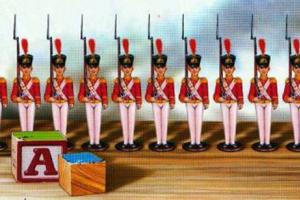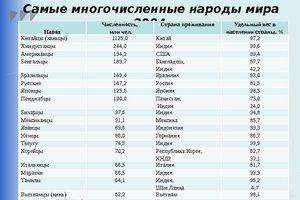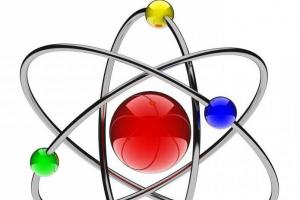TASS DOSSIER. On September 2, every year since 2010, Russia has celebrated a memorable date - the Day of the end of World War II. Established by amendments to the federal law “On days of military glory and memorable dates of Russia” dated March 13, 1995, signed by Russian President Dmitry Medvedev on July 23, 2010.
The international legal basis for establishing a memorial date is the document that marked the end of World War II - the Act of Surrender of Japan, signed on September 2, 1945 on behalf of the United Nations by representatives of the allied states, including the USSR, which were at war with Japan. In the Soviet Union, by decree of the Presidium of the Supreme Soviet of the USSR, Victory Day in Japan was set on September 3, 1945, but this date was not widely celebrated.
The largest military conflict in history
The Second World War lasted six years - from September 1, 1939 to September 2, 1945. It covered territories on three continents: Europe, Asia and Africa, as well as four ocean theaters - Atlantic, Pacific, Indian and Arctic. The war was started by Nazi Germany, fascist Italy and militaristic Japan together with other members of the Berlin-Rome-Tokyo "axis" bloc. In total, 61 states with a total population of 1.7 billion people were drawn into it.
The Great Patriotic War
On June 22, 1941, the Great Patriotic War began with the German attack on the USSR; in the summer of 1941, the creation of an anti-Hitler coalition with the participation of the Soviet Union began. In 1944, the Soviet Workers' and Peasants' Red Army liberated almost the entire occupied territory of the USSR. At midnight on May 8 (May 9 Moscow time), 1945, in the Berlin suburb of Karlshorst, representatives of the German High Command signed the Act of Unconditional Surrender.
War against Japan
On August 8, 1945, the USSR, in accordance with the obligations assumed at the Crimean Conference, declared war on Japan and began military operations on August 9. The next day, the Mongolian People's Republic came out on the side of the USSR, and on August 11, the People's Liberation Army of China went on the offensive against the Japanese occupiers. After the Red Army defeated Japanese forces in Manchuria (northeastern China), Japan signed the Instrument of Surrender on September 2, 1945.
On the Day of the End of World War II, September 2, solemn and commemorative events are held in the Russian Federation.
Casualties in World War II
Official data on Soviet losses in the war of 1941-1945 (8.6 million people) were published after perestroika in the work “Declassified,” which actually went back to calculations made back in the 1960s. However, at the moment, these data are considered outdated due to obvious errors of the research team led by Colonel General Grigory Krivosheev.
Corrected calculations were presented by Colonel Airat Shabaev and war veteran Colonel Sergei Mikhalev in the book “The Tragedy of Confrontation” in 2002. According to these data, the losses of the armed forces in killed, missing and captured amounted to 13 million 698.2 thousand people. Excluding those who returned from captivity - 10 million 921.9 thousand people are irretrievable losses. The losses of the civilian population of the USSR, according to historian Viktor Zemskov, amounted to 20 million people.
The losses of Germany and its allies, according to calculations made from captured Wehrmacht documents in the USSR, as well as by the German historian Rüdiger Overmans, estimate the losses of Germany and its allies on the Soviet-German front at 4 million people (including 600 thousand people - losses allies). In total, during the war of 1939-1945, Germany lost 5.3 million people based on irrevocable demographic losses. Among Germany's allies, Romania suffered the greatest losses - almost 400 thousand people. Japan's losses, according to official data from this country, amounted to 3.1 million people, of which 2.3 million were military personnel.
The irretrievable demographic losses of the United States in the war of 1941-1945, according to a recent Congressional report on losses in various wars, amounted to 405 thousand people. At the same time, 16 million US citizens went through the war. Great Britain lost a little less - 400 thousand people, including non-combat losses.
September 2 is celebrated in Russia as “The Day of the End of World War II (1945).” This memorable date was established by the Federal Law “On Amendments to Article 1(1) of the Federal Law “On Days of Military Glory and Memorable Dates of Russia””, signed by the President of the Russian Federation D. Medvedev on July 23, 2010. To be precise, this holiday cannot be called completely new - it was established on September 3, 1945 - the day after the surrender of Japan - by the Decree of the Presidium of the Supreme Soviet of the USSR as Victory Day over Japan. But for many years, the holiday was virtually ignored in the official calendar of significant dates. Now historical justice has been restored, and September 2 has been declared a public holiday - the Day of Military Glory, in memory of “compatriots who showed dedication, heroism, devotion to their Motherland and allied duty to the member states of the anti-Hitler coalition in implementing the decision of the Crimean (Yalta) Conference of 1945 in Japan." The international legal basis for the establishment of this holiday is the signing of the Act of Surrender of Japan, signed on September 2, 1945 on board the American battleship Missouri by representatives of the allied states, including the USSR, which were at war with Japan and participating in hostilities. This document marked the end of the Second World War, which began on September 1, 1939 with the attack of Nazi Germany on Poland.
The largest war in the history of mankind between two world military-political coalitions lasted six years - from September 1, 1939 to September 2, 1945. It covered the territories of 40 states on three continents: Europe, Asia, Africa, as well as all four ocean theaters (Atlantic, Pacific, Indian and Arctic). 61 states were drawn into it, and the total number of human resources plunged into the war exceeded 1.7 billion people. The Great Patriotic War, when Nazi Germany attacked the USSR, began on June 22, 1941, and then the creation of the anti-Hitler coalition began. On May 8, 1945, the final Act of unconditional surrender of Nazi Germany and its armed forces was signed in Berlin, and May 9 was declared Victory Day in the USSR. The Great Patriotic War is over. Wanting to secure its borders in the Far East and meeting its allies halfway, the USSR, at the Yalta and Potsdam conferences of the leaders of the three allied powers, committed itself to entering the war with Japan two to three months after the end of the war with Germany. On August 8, 1945, in accordance with these obligations, the Soviet Union declared war on Japan and began military operations on August 9. At the final stage of World War II, during the Manchurian strategic, South Sakhalin offensive and Kuril landing operations, the USSR Armed Forces group in the Far East defeated the troops of the Japanese Kwantung Army and liberated northeastern China, North Korea, South Sakhalin and the Kuril Islands. Japan's military-economic potential was seriously undermined, and the defeat of the Kwantung Army forced the country to capitulate. This memorable date is celebrated in many countries around the world. The Second World War was over. It brought incalculable destruction and enormous losses to all states participating in it. The victory of the USSR and the countries of the anti-Hitler coalition over Nazi Germany and militaristic Japan in this war had world-historical significance, had a huge impact on the entire post-war development of mankind, and radically changed the balance of political forces in the world. The history of Russia has always been rich in significant events worthy of being immortalized in people's memory. In all centuries, the heroism and courage of Russian soldiers, the power and glory of Russian weapons have been an integral part of the greatness of the Russian state. The memorable date - September 2 - is a kind of second Victory Day - victory over Japan, which just ended the Second World War - which is celebrated in many countries around the world, and now in Russia. On this day, various commemorative and festive events are held everywhere.
| Days of military glory and Memorable dates of Russia | Memorable dates in Russia | Day of the end of World War II (1945)
September 2
Day of the end of World War II (1945)
September 2 is celebrated in Russia as “The Day of the End of World War II (1945).” This memorable date was established by the Federal Law “On Amendments to Article 1(1) of the Federal Law “On Days of Military Glory and Memorable Dates of Russia””, signed by the President of the Russian Federation D. Medvedev on July 23, 2010.
To be precise, this holiday cannot be called completely new - it was established on September 3, 1945- the day after the surrender of Japan - by Decree of the Presidium of the Supreme Soviet of the USSR as Victory Day over Japan.
But for many years there have been significant dates in the official calendar the holiday was virtually ignored. Now historical justice has been restored, and September 2 has been declared a public holiday - the Day of Military Glory, in memory of “compatriots who showed dedication, heroism, devotion to their Motherland and allied duty to the member states of the anti-Hitler coalition in implementing the decision of the Crimean (Yalta) Conference of 1945 in Japan."
The international legal basis for the establishment of this holiday is the Act of Surrender of Japan, signed on September 2, 1945 on board the American battleship Missouri by representatives of the allied states, including the USSR, which were at war with Japan and participating in hostilities. This document marked the end of the Second World War, which began on September 1, 1939 with the attack of Nazi Germany on Poland.
The largest war in the history of mankind between two world military-political coalitions lasted six years - from September 1, 1939 to September 2, 1945. It covered the territories of 40 states on three continents: Europe, Asia, Africa, as well as all four ocean theaters (Atlantic, Pacific, Indian and Arctic). 61 states were drawn into it, and the total number of human resources plunged into the war exceeded 1.7 billion people. The Great Patriotic War, when Nazi Germany attacked the USSR, began on June 22, 1941, and then the creation of the anti-Hitler coalition began.
On May 8, 1945, the final Act of unconditional surrender of Nazi Germany and its armed forces was signed in Berlin, and May 9 was declared Victory Day in the USSR. The Great Patriotic War is over.
Wanting to secure its borders in the Far East and meeting its allies halfway, the USSR, at the Yalta and Potsdam conferences of the leaders of the three allied powers, committed itself to entering the war with Japan two to three months after the end of the war with Germany. On August 8, 1945, in accordance with these obligations, the Soviet Union declared war on Japan and began military operations on August 9.

At the final stage of World War II, during the Manchurian strategic, South Sakhalin offensive and Kuril landing operations, the grouping of the USSR Armed Forces in the Far East defeated the troops of the Japanese Kwantung Army and liberated northeastern China, North Korea, South Sakhalin and the Kuril Islands. Japan's military-economic potential was seriously undermined, and the defeat of the Kwantung Army forced the country to capitulate. This memorable date is celebrated in many countries around the world.
The Second World War was over. It brought incalculable destruction and enormous losses to all states participating in it. The victory of the USSR and the countries of the anti-Hitler coalition over Nazi Germany and militaristic Japan in this war had world-historical significance, had a huge impact on the entire post-war development of mankind, and radically changed the balance of political forces in the world.
The history of Russia has always been rich in significant events worthy of being immortalized in people's memory. In all centuries, the heroism and courage of Russian soldiers, the power and glory of Russian weapons have been an integral part of the greatness of the Russian state. The memorable date - September 2 - is a kind of second Victory Day - victory over Japan, which just ended the Second World War - which is celebrated in many countries around the world, and now in Russia.
September 2 in Russia is celebrated as "The day the Second World War ended (1945)". This memorable date was established by the Federal Law “On Amendments to Article 1(1) of the Federal Law “On Days of Military Glory and Memorable Dates of Russia””, signed by the President of the Russian Federation D. Medvedev on July 23, 2010.

September 2 is celebrated in Russia Military Glory Day / Image: muuo.ucoz.ru
To be precise, this holiday cannot be called completely new - it was established on September 3, 1945 - the day after the surrender of Japan - by the Decree of the Presidium of the Supreme Soviet of the USSR as Victory Day over Japan. But for many years, the holiday was virtually ignored in the official calendar of significant dates. Now historical justice has been restored, and September 2 has been declared a public holiday - the Day of Military Glory, in memory of “compatriots who showed dedication, heroism, devotion to their Motherland and allied duty to the member states of the anti-Hitler coalition in implementing the decision of the Crimean (Yalta) Conference of 1945 in Japan."
The international legal basis for the establishment of this holiday is the Act of Surrender of Japan, signed on September 2, 1945 on board the American battleship Missouri by representatives of the allied states, including the USSR, which were at war with Japan and participating in hostilities. This document marked the end of the Second World War, which began on September 1, 1939 with the attack of Nazi Germany on Poland.

This memorable date is celebrated in many countries around the world / Photo: calend.ru
The largest war in the history of mankind between two world military-political coalitions lasted six years - from September 1, 1939 to September 2, 1945. It covered the territories of 40 states on three continents: Europe, Asia, Africa, as well as all four ocean theaters (Atlantic, Pacific, Indian and Arctic). 61 states were drawn into it, and the total number of human resources plunged into the war exceeded 1.7 billion people. The Great Patriotic War, when Nazi Germany attacked the USSR, began on June 22, 1941, and then the creation of the anti-Hitler coalition began.
On May 8, 1945, the final Act of unconditional surrender of Nazi Germany and its armed forces was signed in Berlin, and May 9 was declared Victory Day in the USSR. The Great Patriotic War is over.
Wanting to secure its borders in the Far East and meeting its allies halfway, the USSR, at the Yalta and Potsdam conferences of the leaders of the three allied powers, committed itself to entering the war with Japan two to three months after the end of the war with Germany. On August 8, 1945, in accordance with these obligations, the Soviet Union declared war on Japan and began military operations on August 9.
At the final stage of World War II, during the Manchurian strategic, South Sakhalin offensive and Kuril landing operations, the grouping of the USSR Armed Forces in the Far East defeated the troops of the Japanese Kwantung Army and liberated northeastern China, North Korea, South Sakhalin and the Kuril Islands. Japan's military-economic potential was seriously undermined, and the defeat of the Kwantung Army forced the country to capitulate.
The Second World War was over. It brought incalculable destruction and enormous losses to all states participating in it. The victory of the USSR and the countries of the anti-Hitler coalition over Nazi Germany and militaristic Japan in this war had world-historical significance, had a huge impact on the entire post-war development of mankind, and radically changed the balance of political forces in the world.
The history of Russia has always been rich in significant events worthy of being immortalized in people's memory. In all centuries, the heroism and courage of Russian soldiers, the power and glory of Russian weapons have been an integral part of the greatness of the Russian state. The memorable date - September 2 - is a kind of second Victory Day - victory over Japan, which just ended the Second World War - which is celebrated in many countries around the world, and now in Russia. On this day, various commemorative and festive events are held everywhere.
September 2 is celebrated in the Russian Federation as “The Day of the End of World War II (1945).” This memorable date was established in accordance with the Federal Law “On Amendments to Article 1(1) of the Federal Law “On Days of Military Glory and Memorable Dates of Russia”, signed by Russian President Dmitry Medvedev on July 23, 2010. Military Glory Day was established in memory of compatriots who showed dedication, heroism, devotion to their homeland and allied duty to the countries that were members of the anti-Hitler coalition in implementing the decision of the Crimean (Yalta) conference of 1945 on Japan. September 2 is a kind of second Victory Day for Russia, victory in the East.
This holiday cannot be called new - on September 3, 1945, the day after the surrender of the Japanese Empire, Victory Day over Japan was established by Decree of the Presidium of the Supreme Soviet of the USSR. However, for a long time this holiday was practically ignored in the official calendar of significant dates.
The international legal basis for establishing Military Glory Day is the Act of Surrender of the Empire of Japan, which was signed on September 2, 1945 at 9:02 am Tokyo time on board the American battleship Missouri in Tokyo Bay. On the Japanese side, the document was signed by Foreign Minister Mamoru Shigemitsu and Chief of the General Staff Yoshijiro Umezu. Representatives of the Allied Powers were Supreme Commander of the Allied Powers Douglas MacArthur, American Admiral Chester Nimitz, Commander of the British Pacific Fleet Bruce Fraser, Soviet General Kuzma Nikolaevich Derevyanko, Kuomintang General Su Yong-chang, French General J. Leclerc, Australian General T. Blamey, Dutch Admiral K. Halfrich, New Zealand Air Vice-Marshal L. Isit and Canadian Colonel N. Moore-Cosgrave. This document put an end to the Second World War, which, according to Western and Soviet historiography, began on September 1, 1939 with the attack of the Third Reich on Poland (Chinese researchers believe that the Second World War began with the attack of the Japanese army on China on July 7, 1937).
Do not use prisoners of war for forced labor;
Provide units located in remote areas with additional time to cease hostilities.
On the night of August 15, the “young tigers” (a group of fanatical commanders from the department of the War Ministry and the capital’s military institutions, led by Major K. Hatanaka) decided to disrupt the adoption of the declaration and continue the war. They planned to eliminate the "peace supporters", remove the text with a recording of Hirohito's speech about accepting the terms of the Potsdam Declaration and ending the war by the Empire of Japan before it was broadcast, and then persuade the armed forces to continue the fight. The commander of the 1st Guards Division, which guarded the imperial palace, refused to take part in the mutiny and was killed. Giving orders on his behalf, the “young tigers” entered the palace and attacked the residences of the head of government Suzuki, Lord Privy Seal K. Kido, Chairman of the Privy Council K. Hiranuma and the Tokyo radio station. However, they could not find the tapes with the recording and find the leaders of the “peace party”. The troops of the capital garrison did not support their actions, and even many members of the “young tigers” organization, not wanting to go against the emperor’s decision and not believing in the success of the cause, did not join the putschists. As a result, the rebellion failed within the first hours. The instigators of the conspiracy were not tried; they were allowed to commit ritual suicide by cutting open the abdomen.
On August 15, an address from the Japanese Emperor was broadcast on the radio. Given the high level of self-discipline among Japanese government and military leaders, a wave of suicides occurred in the empire. On August 11, the former Prime Minister and Minister of the Army, a staunch supporter of the alliance with Germany and Italy, Hideki Tojo, tried to commit suicide with a revolver shot (he was executed on December 23, 1948 as a war criminal). On the morning of August 15, “the most magnificent example of the samurai ideal” and the Minister of the Army, Koretika Anami, committed hara-kiri; in his suicide note, he asked the emperor for forgiveness for his mistakes. The 1st Deputy Chief of the Naval General Staff (previously the commander of the 1st Air Fleet), the “father of kamikaze” Takijiro Onishi, Field Marshal of the Imperial Japanese Army Hajime Sugiyama, as well as other ministers, generals and officers committed suicide.
The cabinet of Kantaro Suzuki resigned. Many military and political leaders began to favor the idea of a unilateral occupation of Japan by US troops in order to preserve the country from the threat of the communist threat and preserve the imperial system. On August 15, hostilities between the Japanese armed forces and the Anglo-American troops ceased. However, Japanese troops continued to offer fierce resistance to the Soviet army. Parts of the Kwantung Army were not given the order to cease fire, and therefore the Soviet troops were also not given instructions to stop the offensive. Only on August 19, a meeting between the commander-in-chief of Soviet troops in the Far East, Marshal Alexander Vasilevsky, and the chief of staff of the Kwantung Army, Hiposaburo Hata, took place, where an agreement was reached on the procedure for the surrender of Japanese troops. Japanese units began to surrender their weapons, a process that dragged on until the end of the month. The Yuzhno-Sakhalin and Kuril landing operations continued until August 25 and September 1, respectively.
On August 14, 1945, the Americans developed a draft of “General Order No. 1 (for the Army and Navy)” on accepting the surrender of Japanese troops. This project was approved by American President Harry Truman and on August 15 it was reported to the allied countries. The draft specified the zones in which each of the Allied powers had to accept the surrender of Japanese units. On August 16, Moscow announced that it generally agreed with the project, but proposed an amendment - to include all the Kuril Islands and the northern half of Hokkaido in the Soviet zone. Washington did not raise any objections regarding the Kuril Islands. But regarding Hokkaido, the American President noted that the Supreme Commander of Allied Forces in the Pacific, General Douglas MacArthur, was surrendering to the Japanese armed forces on all the islands of the Japanese archipelago. It was specified that MacArthur would use token armed forces, including Soviet units.
The American government from the very beginning did not intend to let the USSR into Japan and rejected allied control in post-war Japan, which was provided for by the Potsdam Declaration. On August 18, the United States put forward a demand to allocate one of the Kuril Islands for the American Air Force base. Moscow rejected this brazen advance, declaring that the Kuril Islands, according to the Crimean Agreement, are the possession of the USSR. The Soviet government announced that it was ready to allocate an airfield for landing American commercial aircraft, subject to the allocation of a similar airfield for Soviet aircraft in the Aleutian Islands.
On August 19, a Japanese delegation led by Deputy Chief of the General Staff, General T. Kawabe, arrived in Manila (Philippines). The Americans notified the Japanese that their forces must liberate the Atsugi airfield on August 24, the Tokyo Bay and Sagami Bay areas by August 25, and Kanon Base and the southern part of Kyushu Island by mid-day on August 30. Representatives of the Imperial Japanese Armed Forces requested a delay in the landing of the occupying forces by 10 days in order to strengthen precautions and avoid unnecessary incidents. The request of the Japanese side was granted, but for a shorter period. The landing of the advanced occupation forces was scheduled for August 26, and the main forces for August 28.
On August 20, the Japanese in Manila were presented with an Act of Surrender. The document provided for the unconditional surrender of the Japanese armed forces, regardless of their location. Japanese troops were required to immediately cease hostilities, release prisoners of war and interned civilians, ensure their maintenance, protection and delivery to designated places. On September 2, the Japanese delegation signed the Instrument of Surrender. The ceremony itself was structured to highlight the United States' primary role in defeating Japan. The procedure for the surrender of Japanese troops in various areas of the Asia-Pacific region dragged on for several months.

